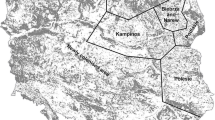Abstract
We illustrate 2 techniques for estimating age-specific hazards with wildlife telemetry data: Siler’s (Ecology 60:750–757, 1979) competing risk model fit using maximum likelihood and a penalized likelihood estimate that only assumes the hazard varies smoothly with age. In most telemetry studies, animals enter at different points in time (and at different ages), leading to data that are left-truncated. In addition, death times may only be known to occur within an interval of time (interval-censoring). Observations may also be right-censored (e.g., due to the end of the study, radio-collar failure, or emigration from the study area). It is important to consider the observation process, since the contribution of each individual’s data to the likelihood will depend on whether data are left-truncated or censored. We estimate age-specific hazards using telemetry data collected in two Phases during a 13-year study of white-tailed deer (Odocoileus virginianus) in northern Minnesota. The hazards estimated from the two methods were similar for the full data set that included 302 adults and 76 neonates (followed since or shortly after birth). However, estimated hazards for early-aged individuals differed considerably for subsets of the data that did not include neonates. We discuss the advantages and disadvantages of these two modeling approaches and also compare the estimators using a short simulation study.
Similar content being viewed by others
References
Barlow J, Boveng P (1991) Modeling age-specific mortality for marine mammal populations. Mar Mamm Sci 7(1): 50–65
Bowman JL, Jacobson HA (1998) An improved vaginal-implant transmitter for locating white-tailed deer birth sites and fawns. Wildl Soc Bull 26: 295–298
Carstensen B (2006a) Demography and epidemiology: age-Period-Cohort models in the computer age. Technical Report 06.1, Department of Biostatistics, University of Copenhagen, Copenhagen, Denmark. Available via http://biostat.ku.dk/reports/2006/. Accessed 5 May 2009
Carstensen B (2006b) Demography and epidemiology: practical use of the Lexis diagram in the computer age. Or: who needs the cox-model anyway? Technical Report 06.2, Department of Biostatistics, University of Copenhagen, Copenhagen, Denmark. Available via http://biostat.ku.dk/reports/2006/. Accessed 5 May 2009
Carstensen M, DelGiudice GD, Sampson BA (2003) Using doe behavior and vaginal implant transmitters to capture neonate white-tailed deer in north central Minnesota. Wildl Soc Bull 31: 634–641
Casella G, Berger RL (1990) Statistical inference. Duxbury Press, Belmont
DelGiudice GD, Riggs MR, Joly P, Pan W (2002) Winter severity, survival, and cause-specific mortality of female white-tailed deer in north–central Minnesota. J Wildl Manage 66: 698–717
DelGiudice GD, Sampson BA, Kuehn DW, Powell MC, Fieberg J (2005) Understanding margins of safe capture, chemical immobilization, and handling of free-ranging white-tailed deer. Wildl Soc Bull 33: 677–687
DelGiudice GD, Fieberg J, Powell MC, Riggs MR, Pan W (2006) A long-term age-specific survival analysis of female white-tailed deer. J Wildl Manage 70: 1556–1568
Dennis JE, Schnabel RB (1983) Numerical methods for unconstrained optimization and nonlinear equations. Prentice-Hall, Englewood Cliffs
Du P, Gu C (2005) Penalized likelihood hazard estimation: efficient approximation and Bayesian confidence intervals. Stat Probab Lett 76: 244–254
Eberhardt LL (1985) Assessing the dynamics of wild populations. J Wildl Manage 49: 997–1012
Fieberg J, DelGiudice GD (2009) What time is it? choice of time origin and scale in extended proportional hazards models. Ecology (in press)
Fieberg J, DelGiudice GD (2008) Exploring migration data using interval-censored time-to-event models. J Wildl Manage 72: 1211–1219
Finch CE, Pike MC, Witten M (1990) Slow mortality rate accelerations during aging in some animals approximate that of humans. Science 249: 902–905
Gage TB (1998) The comparative demography of primates: with some comments on the evolution of life histories. Annu Rev Anthropol 27: 197–221
Gage TB (1989) Bio-mathematical approaches to the study of human variation in mortality. Yearb Phys Anthropol 32: 185–214
Gaillard J-M, Festa-Bianchet M, Yoccoz NG (1998) Population dynamics of large herbivores: variable recruitment with constant adult survival. Trends Ecol Evol 13: 58–63
Gaillard J-M, Festa-Bianchet M, Yoccoz NG, Loison A, Toigo C (2000) Temporal variation in fitness components and population dynamics of large herbivores. Annu Rev Ecol Syst 31: 367–393
Gu C (2002) Smoothing spline ANOVA models. Springer, New York
Gu C (2006) Gss: general smoothing splines. R package version 0.9-3
Joly P, Commenges D, Letenneur L (1998) A penalized likelihood approach for arbitrarily censored and truncated data: application to age-specific incidence of dementia. Biometrics 54: 185–194
Kalbfleisch JD, Prentice RL (2002) The statistical analysis of failure time data. John Wiley, Hoboken
Lebreton J-D, Burnham KP, Clobert J, Anderson DR (1992) Modeling survival and testing biological hypotheses using marked animals: a unified approach with case studies. Ecol Monogr 62: 57–118
Nychka D (1988) Bayesian confidence intervals for smoothing splines. J Am Stat Assoc 83: 1134–1143
Pan W, Chappell R (1998) A nonparametric estimator of survival functions for arbitrarily truncated and censored data. Lifetime Data Anal 4: 187–202
R Development Core Team (2008) R: a language and environment for statistical computing. R Foundation for Statistical Computing, Vienna, Austria. ISBN 3-900051-07-0. Available via http://www.R-project.org. Accessed 20 May 2009
Siler W (1979) A competing-risk model for animal mortality. Ecology 60: 750–757
Simonoff JS (1996) Smoothing methods in statistics. Springer, New York
Tsai W-T (1988) Estimation of the survival function with increasing failure rate based on left-truncated and right censored data. Biometrika 75: 319–324
Wahba G (1983) Bayesian “confidence intervals” for the cross-validated smoothing spline. J R Stat Soc B Stat Methodol 45: 133–150
White GC, Burnham KP (1999) Program MARK: survival estimation from populations of marked animals. Bird Study 46(Supplement): 120–138
Wood JW, Holman DJ, Weiss KM, Buchanan AV, LeFor B (1992) Hazard models for human population biology. Yearb Phys Anthropol 35: 43–87
Woodroofe M (1985) Estimating a distribution function with truncated data. Ann Stat 13: 163–177
Author information
Authors and Affiliations
Corresponding author
Rights and permissions
About this article
Cite this article
Fieberg, J., DelGiudice, G.D. Estimating age-specific hazards from wildlife telemetry data. Environ Ecol Stat 18, 209–222 (2011). https://doi.org/10.1007/s10651-009-0128-x
Received:
Revised:
Published:
Issue Date:
DOI: https://doi.org/10.1007/s10651-009-0128-x




